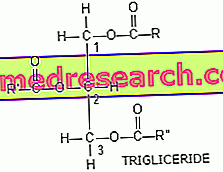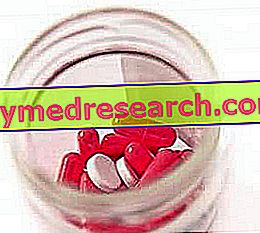With the diet we introduce lipids in the form of:
triglycerides (98%),
cholesterol, phospholipids and fat-soluble vitamins (2%).
A triglyceride consists of a molecule of glycerol esterified with three fatty acids.

The digestion of lipids is deeply conditioned by their poor solubility in water, which is the fundamental element within the digestive tract. Thus, when they are in the aqueous environment given by saliva, gastric, intestinal, pancreatic and biliary secretions, the fats aggregate together, separating from the aqueous medium.
In the lumen of the stomach the lipids gather in macromolecules isolated from the hydrophilic component of the chyme, a bit like what happens in the broth where the lipid drops are separated from the aqueous part.
This feature greatly complicates the digestive processes, since the enzymes responsible for the digestion of fats, being water-soluble, are able to attack only the surface lipids, without being able to penetrate inside the drop. Their effectiveness is therefore modest.
In the stomach the gastric lipase attacks the triglycerides, detaching one of the three fatty acids, with consequent formation of free fatty acids and diglycerides. The digestive effectiveness of this enzyme is strongly reduced by the hydrophobic nature of lipids and by the strong gastric acidity. In the 2-4 hours in which the food remains in the stomach this enzyme, together with the salivary lipases, digests about 10-30% of the food lipids.

In the duodenum (initial tract of the small intestine) an enzyme is called, called pancreatic lipase, which covers the same function as gastric lipase and salivary. Its digestive action is however facilitated by the bile salts present in the bile and by the slight basicity that characterizes the intestinal lumen.
Bile salts are synthesized by the liver from cholesterol and, unlike their precursor, are amphipathic molecules. The bile salts are in fact formed by a fat-soluble component and by another water-soluble component, with lots of negative charges directed towards the external part (it is defined as amphipathic or amphiphilic, a molecule containing a hydrophilic and a hydrophobic group; the most classic example is given by the phospholipids that make up the cell membrane).
After being placed in the intestine, the bile salts are inserted into the lipid droplets with their liposoluble portion. In this way they reduce the cohesion between the various triglycerides, greatly facilitating the digestive activity of pancreatic lipases. At the same time, the continuous mixing of the intestinal contents, favored by peristaltic contractions, contributes to the breakdown of lipid droplets into much smaller molecules.

The entire process, which takes the name of emulsion, is irreversible (thanks to the negative electric charge of the water-soluble component of the bile salts which repels the various lipid molecules).
When we beat with a fork (intestinal peristalsis) a suspension of oil and water, the two phases, after being temporarily associated, quickly return to separate. In the intestine, lipid re-aggregation is inhibited by bile salts and other tensioptic molecules
Thanks to this reduction in lipid droplets, the contact surface of the lipases with the substrates greatly increases and together with it also the digestive efficacy of these enzymes. The adhesion of lipases to fat droplets is hindered by the layer of bile salts surrounding the lipid drop; for this reason the digestion of fats requires the presence of an additional pancreatic enzyme, called colipase, which increases the adhesion of lipase to lipid droplets.
Unlike the gastric lipase, the pancreatic one detaches from the triglyceride not one but two fatty acids, with the formation of monoglycerides and free fatty acids.

The final products of lipid digestion are free fatty acids, monoglycerides and lysophospholipids deriving from the digestion of phospholipids (digested by a phospholipase present in pancreatic juice).
As these compounds are formed, they come out of the drops and bile salts and lysophospholipids are collected together with cholesterol, in very small soluble structures, called micelles, which convey them to the enterocytes responsible for their absorption. In the composition of the micelles the short and medium chain fatty acids do not become part which, by virtue of the greater water solubility, remain in the aqueous medium.
Bile salts are essential both for the digestion of lipids, thanks to their emulsifying properties, and for their absorption, since they intervene in the formation of lipid micelles.
If bile were not poured into the intestine, most of the fat taken with food would pass into the faeces in an undigested form (steatorrhea)
Free cholesterol and fat-soluble vitamins are absorbed as such, without undergoing particular digestive processes (to be absorbed, esterified cholesterol is hydrolyzed to free cholesterol + fatty acid by pancreatic esterase).



